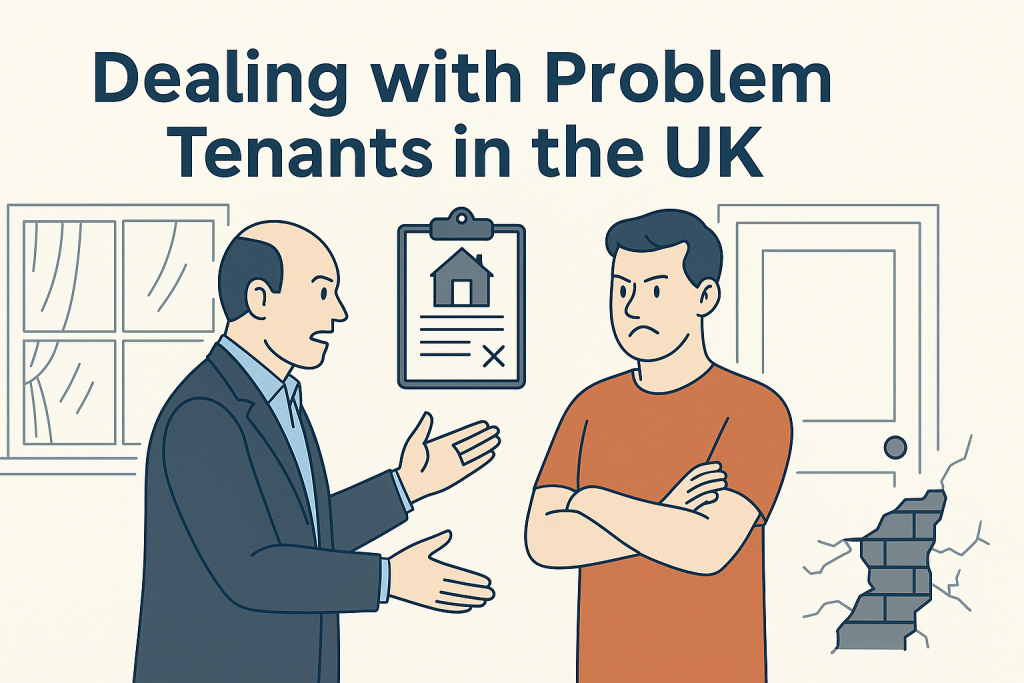Disputes, Diplomacy, and Eviction
Being a landlord isn’t just about collecting rent—it’s about people. Most tenants are responsible and respectful, but occasionally you’ll face challenges: late rent, antisocial behaviour, property neglect, or outright refusal to leave.
What separates successful landlords from frustrated ones is how they handle problem tenants. Diplomacy, early action, and a firm grasp of the law can transform disputes into solutions—and when eviction is unavoidable, following the correct legal process ensures you regain control without costly mistakes.
This useful guide walks you through the best options for UK landlords dealing with problem tenants. From prevention and negotiation to serving notices and court proceedings, you’ll find practical steps, real examples, and links to official government resources.

Prevention First: Screening and Setting Expectations
Why prevention matters
The easiest tenant problem to fix is the one you never have. A solid tenancy foundation dramatically reduces risks.
Tenant checks
Full credit and rent history checks via a referencing service
Employer references or guarantors where appropriate
Previous landlord references (with tenant consent)
Transparency: keep records of checks to show fairness and compliance
Written agreements & inventories
Use a strong, legally valid tenancy agreement (AST if in England/Wales)
Inventory with dated photos and tenant signature
Clearly state rent dates, responsibilities, and inspection rights
Relationship management
Routine inspections with proper notice
Quick response to maintenance issues (shows professionalism and reduces tenant excuses)
A “house handbook” with clear expectations
Early Intervention: Talk Before You Serve
When problems start, resist the urge to go straight for eviction. Landlords who negotiate first often get better results.
Diplomacy works because:
Court is costly and slow (6+ months for possession is common)
Tenants may be willing to remedy issues when approached calmly
A paper trail of efforts helps your case if matters escalate
Steps to try first
Informal chat – a phone call or visit (with notice).
Written warning – outline the problem, clause breached, and request remedy.
Repayment plan – if arrears exist, agree staged payments.
Mediation – many councils and charities offer free/low-cost mediation.
📌 Official guidance: GOV.UK – Settling disputes
When Diplomacy Fails: Notices and Legal Options
Section 21 (“No-Fault” Eviction)
Use when you want possession without proving tenant fault
Requires at least 2 months’ notice
Only valid if:
Deposit protected properly
Tenant given EPC, Gas Safety, and How to Rent guide
Correct form used (Form 6A)
If any step is missed, notice may be invalid
📌 Official guidance: GOV.UK – Section 21
Section 8 (Breach of Tenancy)
Used for specific breaches (rent arrears, antisocial behaviour, property damage)
Must cite statutory grounds (e.g. Ground 8: rent arrears of 2+ months)
Notice period: 2 weeks–2 months depending on ground
If tenant doesn’t comply, apply to court for possession
📌 Official guidance: GOV.UK – Section 8
Court Process & Eviction
If tenant stays, apply to court for possession order
Present evidence: rent records, photos, letters, witness statements
If possession granted but tenant still refuses to leave, apply for a warrant of possession
Bailiffs/enforcement officers carry out eviction—not the landlord
📌 Official guidance: GOV.UK – Eviction notices & bailiffs
⚠️ Never attempt “DIY eviction” (changing locks, cutting off power, intimidation). It is illegal under the Protection from Eviction Act 1977 and can lead to criminal charges.
Common Pitfalls for Landlords
Serving invalid notices (wrong form, missing documents, invalid deposit protection)
Harassment or illegal eviction tactics
Poor evidence in court
Allowing arrears/damage to mount without early action
Ignoring licensing or safety regulations (weakens your case)
📌 Tenant rights: Shelter – Illegal Eviction
Real Examples: Diplomacy in Action
Example 1: Late Rent
Tenant lost job → Landlord offered repayment plan → Tenant caught up over 3 months → Eviction avoided.
Example 2: Noise Complaints
Neighbours complained of loud parties → Landlord warned → Tenant ignored → Section 8 served (Ground 14) → Court possession granted.
Example 3: Neglect & Damage
Inspection revealed major neglect → Evidence logged → Formal letter sent → Tenant failed to act → Section 8 (Ground 13) → Court granted eviction & damages.
Practical Checklist for Landlords
| Step | Action | Why It Matters |
|---|---|---|
| Screen tenants | References, credit check | Reduces risk |
| Written AST & inventory | Clear clauses, photos | Strong evidence |
| Act early | Warnings & repayment offers | Prevent escalation |
| Keep records | Emails, rent statements, inspection notes | Evidence in court |
| Serve correct notice | Section 21 or 8 | Valid claim |
| Court application | Possession order | Legal enforcement |
| Bailiff enforcement | Only legal route | Avoids liability |
Final Thoughts
Problem tenants are part of the reality of being a landlord. But with early diplomacy, proper evidence, and correct legal steps, you can protect your investment while staying professional.
Landlords who manage disputes with firm fairness often achieve better outcomes—whether that means a repaired relationship, recovered rent, or a legally sound eviction.
For UK landlords, the key takeaway is simple: stay factual, follow the law, and act early.
